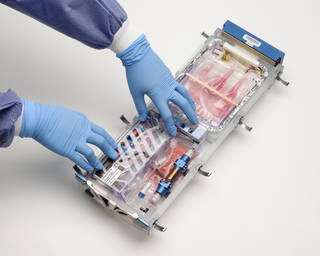Cell Science
Studying How Life Changes in Space
Some aspects of life function differently in space, and biologists can learn a lot about how it impacts human health by studying cells grown in the microgravity environment, or weightlessness, of the International Space Station. The Bioculture System, developed at NASA’s Ames Research Center in Silicon Valley, is a new research facility for the orbiting laboratory that will let scientists carry out long-term cell biology studies, on a broad range of subjects and diverse cell and tissue types. This new cell and tissue culture hardware now allows for real-time, remote monitoring of cell cultures and finer control over the conditions in which they grow.

Interior view of an incubator cassette from the Bioculture System.
Cell Science-Validation
The first mission to use the Bioculture System, called Cell Science-Validation, fully tested the system’s engineering and life support, to make sure it can function properly in microgravity, and successfully grow bone and heart cells on the space station. The Bioculture System returned live, beating heart cell (cardiomyocyte) cultures to Earth, and automatically preserved bone cells (osteocytes) for genomic analysis back on Earth.
Now that the initial validation phase is complete, this facility is available aboard the U.S. National Lab for additional experiments from the broad scientific community, including academia, government and industry.
The Bioculture System will enable new advanced research, ranging from areas such as fundamental cell biology to drug discovery, microbiology and tissue engineering. Future studies will help scientists better understand how the key factors of spaceflight – microgravity and space radiation – can affect human health, both on Earth and in space during long exploration voyages.
Source: National Aeronautics and Space Administration
- 299 reads
Human Rights
Fostering a More Humane World: The 28th Eurasian Economic Summi

Conscience, Hope, and Action: Keys to Global Peace and Sustainability

Ringing FOWPAL’s Peace Bell for the World:Nobel Peace Prize Laureates’ Visions and Actions

Protecting the World’s Cultural Diversity for a Sustainable Future

Puppet Show I International Friendship Day 2020

